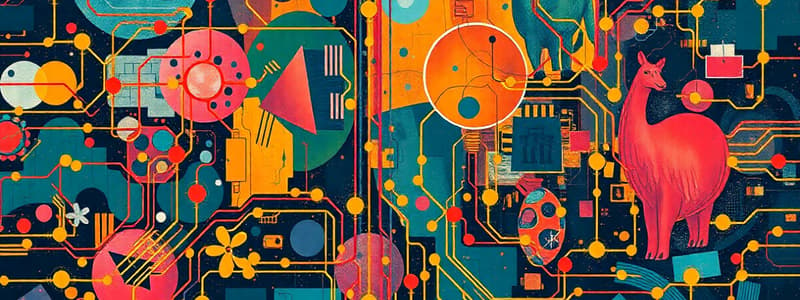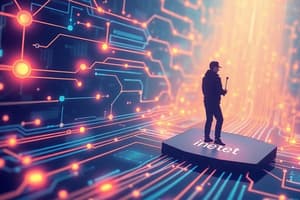Podcast
Questions and Answers
Which of the following technologies is classified as a Personal Area Network and operates wirelessly?
Which of the following technologies is classified as a Personal Area Network and operates wirelessly?
- Ethernet
- Wimax
- ZigBee (correct)
- Wi-Fi
What is the primary purpose of data aggregation in IoT?
What is the primary purpose of data aggregation in IoT?
- To simplify data handling, processing, and storage (correct)
- To enhance the speed of data transmission
- To increase the volume of collected data
- To ensure data ownership is retained
Which of the following is considered a Regulatory Standard in IoT?
Which of the following is considered a Regulatory Standard in IoT?
- Data-aggregation protocols
- Ownership, use, and sale of data (correct)
- Network protocols
- Communication protocols
Which augmented intelligence analysis focuses on recommending actions to optimize outcomes?
Which augmented intelligence analysis focuses on recommending actions to optimize outcomes?
What is the role of Technology Standards in IoT data aggregation?
What is the role of Technology Standards in IoT data aggregation?
Which of the following connectivity types is NOT associated with Local Area Networks?
Which of the following connectivity types is NOT associated with Local Area Networks?
What kind of analysis does augmented intelligence NOT support?
What kind of analysis does augmented intelligence NOT support?
Which technology operates over a Metropolitan Area Network?
Which technology operates over a Metropolitan Area Network?
What is the primary function of sensors in IoT systems?
What is the primary function of sensors in IoT systems?
Which technology is primarily responsible for enabling communication between devices in IoT?
Which technology is primarily responsible for enabling communication between devices in IoT?
What role do actuators play in IoT systems?
What role do actuators play in IoT systems?
Which stage in the IoT functional view is responsible for data aggregation?
Which stage in the IoT functional view is responsible for data aggregation?
Which of the following is NOT considered an enabler of IoT systems?
Which of the following is NOT considered an enabler of IoT systems?
What is the main purpose of aggregation standardizations in IoT?
What is the main purpose of aggregation standardizations in IoT?
Which component is responsible for analyzing the data in an IoT system?
Which component is responsible for analyzing the data in an IoT system?
How does identification in IoT contribute to its functionality?
How does identification in IoT contribute to its functionality?
What is the primary function of the Object Abstraction Layer in the IoT architecture?
What is the primary function of the Object Abstraction Layer in the IoT architecture?
Which layer in the IoT architecture is tasked with the pairing of services with their requesters' applications?
Which layer in the IoT architecture is tasked with the pairing of services with their requesters' applications?
What is a key responsibility of the Application Layer in the six-layer IoT architecture?
What is a key responsibility of the Application Layer in the six-layer IoT architecture?
Which layer is responsible for automatic decision-making based on Big Data analysis?
Which layer is responsible for automatic decision-making based on Big Data analysis?
What are the responsibilities of the Cognizance Layer in the six-layer IoT architecture?
What are the responsibilities of the Cognizance Layer in the six-layer IoT architecture?
Which layer involves the categorization of received information?
Which layer involves the categorization of received information?
Which layer focuses on the identification of smart objects and aspects of IoT systems?
Which layer focuses on the identification of smart objects and aspects of IoT systems?
Which layer is responsible for secure data transmission from sensors to the application layer?
Which layer is responsible for secure data transmission from sensors to the application layer?
What is the primary challenge of the perception layer in IoT architecture?
What is the primary challenge of the perception layer in IoT architecture?
Which technology is NOT mentioned as part of the network layer's communication technologies?
Which technology is NOT mentioned as part of the network layer's communication technologies?
What function does the application layer serve in the five-layer IoT architecture?
What function does the application layer serve in the five-layer IoT architecture?
Which of the following layers is responsible for information processing and data storage?
Which of the following layers is responsible for information processing and data storage?
How does the perception layer primarily collect information?
How does the perception layer primarily collect information?
Which responsibility is associated with the network layer?
Which responsibility is associated with the network layer?
Which type of analysis is the application layer responsible for performing?
Which type of analysis is the application layer responsible for performing?
What component of an RFID system is responsible for storing information in a database?
What component of an RFID system is responsible for storing information in a database?
What role do physical sensors play in the perception layer?
What role do physical sensors play in the perception layer?
Which type of RFID tag has an on-board power source?
Which type of RFID tag has an on-board power source?
What is a defining characteristic of the communication between RFID tags and interrogators?
What is a defining characteristic of the communication between RFID tags and interrogators?
Which of the following is NOT typically a type of wireless communication used in IoT?
Which of the following is NOT typically a type of wireless communication used in IoT?
What is required to ensure continuous connectivity of smart things on the Internet?
What is required to ensure continuous connectivity of smart things on the Internet?
What advantages do Active RFID Tags have over Passive RFID Tags?
What advantages do Active RFID Tags have over Passive RFID Tags?
In a Wireless Sensor Network (WSN), what ability do sensors possess?
In a Wireless Sensor Network (WSN), what ability do sensors possess?
What is a primary purpose of collecting sensed data in IoT systems?
What is a primary purpose of collecting sensed data in IoT systems?
What is the primary focus of the IoT reference architecture?
What is the primary focus of the IoT reference architecture?
What basic functionality does the Edge/Fog Computing layer perform?
What basic functionality does the Edge/Fog Computing layer perform?
Which of the following describes the purpose of the Data Accumulation layer?
Which of the following describes the purpose of the Data Accumulation layer?
What is one of the primary roles of the Data Abstraction Layer?
What is one of the primary roles of the Data Abstraction Layer?
At which layer is relevant data interpretation performed based on application requirements?
At which layer is relevant data interpretation performed based on application requirements?
How does efficient data organization at the Application Layer affect information processing?
How does efficient data organization at the Application Layer affect information processing?
What is an example of a device that operates at the Edge/Fog Computing layer?
What is an example of a device that operates at the Edge/Fog Computing layer?
What is a key function of the Data Accumulation layer regarding data management?
What is a key function of the Data Accumulation layer regarding data management?
Flashcards
IoT Enablers
IoT Enablers
Factors that facilitate the development and functioning of IoT systems.
IoT Functional Stages
IoT Functional Stages
Five stages of the information processing loop in IoT (creation, communication, aggregation, analysis, action).
Sensors (IoT)
Sensors (IoT)
Devices that detect and measure physical properties and convert them into electrical signals in IoT systems.
Actuators (IoT)
Actuators (IoT)
Signup and view all the flashcards
Identification Technologies (IoT)
Identification Technologies (IoT)
Signup and view all the flashcards
Wireless Communication (IoT)
Wireless Communication (IoT)
Signup and view all the flashcards
Aggregation Standardization (IoT)
Aggregation Standardization (IoT)
Signup and view all the flashcards
Augmented Intelligence (IoT)
Augmented Intelligence (IoT)
Signup and view all the flashcards
RFID Tag
RFID Tag
Signup and view all the flashcards
Interrogator (RFID)
Interrogator (RFID)
Signup and view all the flashcards
Active RFID Tag
Active RFID Tag
Signup and view all the flashcards
Passive RFID Tag
Passive RFID Tag
Signup and view all the flashcards
RFID System
RFID System
Signup and view all the flashcards
Wireless Communications in IoT
Wireless Communications in IoT
Signup and view all the flashcards
WSN (Wireless Sensor Network)
WSN (Wireless Sensor Network)
Signup and view all the flashcards
IP Address in IoT
IP Address in IoT
Signup and view all the flashcards
IoT Wireless Communication
IoT Wireless Communication
Signup and view all the flashcards
Data Aggregation in IoT
Data Aggregation in IoT
Signup and view all the flashcards
IoT Standardization
IoT Standardization
Signup and view all the flashcards
Technology Standards (IoT)
Technology Standards (IoT)
Signup and view all the flashcards
Regulatory Standards (IoT)
Regulatory Standards (IoT)
Signup and view all the flashcards
Descriptive Analysis
Descriptive Analysis
Signup and view all the flashcards
Predictive Analysis
Predictive Analysis
Signup and view all the flashcards
Network Layer
Network Layer
Signup and view all the flashcards
Middleware Layer
Middleware Layer
Signup and view all the flashcards
Application Layer
Application Layer
Signup and view all the flashcards
Business Layer
Business Layer
Signup and view all the flashcards
Cognizance Layer
Cognizance Layer
Signup and view all the flashcards
Focus Layer
Focus Layer
Signup and view all the flashcards
What are the responsibilities of the Competence Business Layer?
What are the responsibilities of the Competence Business Layer?
Signup and view all the flashcards
What is the purpose of the Infrastructure Layer?
What is the purpose of the Infrastructure Layer?
Signup and view all the flashcards
Perception Layer Challenge
Perception Layer Challenge
Signup and view all the flashcards
Network Layer Function
Network Layer Function
Signup and view all the flashcards
Network Layer Communication
Network Layer Communication
Signup and view all the flashcards
Application Layer Services
Application Layer Services
Signup and view all the flashcards
Object Layer
Object Layer
Signup and view all the flashcards
Sensor Principles
Sensor Principles
Signup and view all the flashcards
Five-Layer IoT Architecture
Five-Layer IoT Architecture
Signup and view all the flashcards
Object Abstraction Layer
Object Abstraction Layer
Signup and view all the flashcards
Horizontal Communication
Horizontal Communication
Signup and view all the flashcards
Gateway Standardization
Gateway Standardization
Signup and view all the flashcards
Edge/Fog Computing
Edge/Fog Computing
Signup and view all the flashcards
Data Formatting and Evaluation
Data Formatting and Evaluation
Signup and view all the flashcards
Data Accumulation
Data Accumulation
Signup and view all the flashcards
Data Filtering
Data Filtering
Signup and view all the flashcards
Data Abstraction
Data Abstraction
Signup and view all the flashcards
Data Interpretation for Applications
Data Interpretation for Applications
Signup and view all the flashcards
Study Notes
Internet of Things I - Lecture 2
- IoT General Enablers are the foundational components enabling IoT systems
- Ubiquitous computing involves real-life objects that sense, communicate, analyze, and act based on the situation.
- Key general enablers include miniaturization, portability, ubiquitous connectivity, integration of diverse devices, and pervasive digital ecosystems (like the cloud).
- The five stages of IoT functional view/information value loop are data creation, communication, aggregation, analysis, and action. These stages are crucial for achieving set goals.
IoT Enabling Technologies
- Identification and Sensing Technologies: Develop devices (sensors) converting physical stimuli into electronic signals.
- Wireless Communication and Networking: Enable electronic signal communication between devices. This includes specific technologies like RFID (with components tag, interrogator, and controller). Different communication types (like Radio Frequency Identification) are important to understanding data transmission.
- Aggregation Standardizations: Enable efficient data processing and interoperability of aggregated data sets.
- Augmented Intelligence: Analytical tools improve the ability to describe and predict relationships among sensed data.
- Augmented Behavior: Technologies and techniques improve compliance with prescribed actions.
IoT Identification and Sensing Technologies
- Identification methods provide unique object identities within a network, typically through public IP addressing.
- Sensing in IoT involves originating data from interconnected smart things using sensors and actuators.
- Sensors produce electrical, optical, or digital data from the physical environment for interpreting information for intelligent devices or people.
- Actuators convert electronic signals to non-electronic energy to complete a feedback loop.
Wireless Communication and Networking
- Wireless communication and networking are pivotal for IoT functioning.
- Wireless Identification and Sensing Technologies (WIST) is an important term for RFID based sensors and WSNs.
- A typical RFID system consists of an RFID tag (Transponder or Smart Label), an interrogator (Reader), and a controller (Host).
- Active RFID tags have an on-board power source, offering advantages like range and high data transmission.
- Passive RFID tags rely on external power sources, they are more affordable but less versatile.
- RFID, sensors, and RFID sensors connect to the internet through heterogeneous network devices (like Bluetooth, Access Points, Wi-Fi routers, Gateways, etc).
- A unique IP address is needed for each smart thing.
- IoT strongly relies on continuous connectivity.
Aggregation Standardization
- Aggregation brings together sensed data for easier handling, processing, and storage. This makes it possible to derive meaningful conclusions for future decision making.
- Standardization is crucial for IoT to ensure interoperability, reusability, scalability, relevant data semantics, and security.
- Standards include network protocols, communication protocols, and data-aggregation protocols within the context of IoT. Regulatory standards deal with ownership, use, and sale of data.
Augmented Intelligence
- Analysis of data demands augmented cognitive technologies.
- Augmented intelligence automates systems to perform descriptive, predictive, and prescriptive analyses.
- Computer vision, natural language processing, and speech recognition play crucial roles in predictive and prescriptive analytics.
Augmented Behavior
- Augmented behavior involves actions considering all phases of the information value loop, from sensing to data analysis.
- Actions in the context of people and organizational processes are supportive of manifesting actions.
- Machine-to-machine (M2M) and machine-to-human (M2H) technologies are important here.
- The transition from data science to behavioral sciences takes place at this phase. This leads to cognitive and action abilities in machines for environmental understanding.
IoT Architectures
- IoT systems connect diverse hardware devices across multiple applications.
- The heterogeneity of devices poses key challenges for successful deployment.
- Ubiquitous connectivity, scalability, interoperability, security/privacy, and high traffic and storage needs affect IoT system architecture.
- IoT elements include; sensing, digital identification, services, communication, semantics, and computation.
- Three-Layer architecture has perception, network, and application layers involved.
- Five-layer IoT architecture involves Object (Perception), Object Abstraction (Network), Service Management (Middleware), Application, and Business layers.
- Six-Layer: Focus, Cognizance, Transmission, Application, Infrastructure, Competence
- Seven-Layer: Collaboration (and) Processes, Application, Data Abstraction, Data Accumulation, Fog/Edge, Connectivity, Things.
Perception Layer
- The perception layer collects various information types from physical sensors (e.g., RFID, sensor objects, etc.).
- This layer transmits processed information to the next layer through service interfaces.
- Perception of environmental factors, using low-power and nanoscale technology in smart things, is a challenge.
Network Layer
- The network layer (also called the transmission layer) forwards data from the perception layer to the internet and other communication technologies.
- Various communication technologies (e.g., WLAN, Wi-Fi, LTE, Bluetooth) are integrated with IoT gateways to transmit data.
- The network layer performs data operations within the cloud.
Application Layer
- The application layer provides requested services to users (e.g. temperature, moisture, humidity, etc.).
- Besides user-requested services (e.g., temperature, humidity), the application layer provides data management services (e.g., warehousing, Big data storage, data mining) for semantic data analysis.
Business Layer
- The business layer manages overall activities/services within the IoT system.
- Services are managed through charts, business models, and graphs derived from received data.
- Automatic decision-making and development of smart business strategies are supported using Big Data analysis within this layer.
Focus Layer
- Modules in this layer identify smart objects, focusing on the aspects of the considered IoT system.
Cognizance Layer
- This layer consists of sensors, actuators, and data monitoring modules responsible for collecting sensing information from smart objects.
Transmission Layer
- This layer manages the transmission of sensed data from the cognizance layer to the application layer.
Infrastructure Layer
- This layer handles the availability and access to service-oriented technologies (e.g., cloud computing, big data technology, etc.)
Collaboration and Processes
- In IoT, multiple individuals usually use the same application for various purposes. The primary goal is empowerment, enabling better workflows and collaboration. Processes related to business mostly transcend the boundaries of individual applications.
Studying That Suits You
Use AI to generate personalized quizzes and flashcards to suit your learning preferences.




